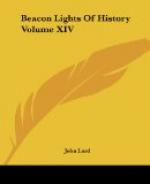of the Hittites and all their allies in a great battle
at Carchemish. That great mound of Carchemish
needs to be thoroughly explored. Already an English
expedition has very carelessly just opened the hill
and exposed, but not fairly published, some few as
fine friezes as are to be found in the Assyrian capitals,
with unread Hittite inscriptions, and a fine statue
of the Hittite Venus; but much remains to reward the
student of Oriental history and art. At Senjirli
a German expedition under Von Luschan has done more
and better work, handsomely published, but this was
a smaller Syrian town, and less was to be expected;
and yet here, and near by, were found what was not
expected, steles (upright slabs or pillars) with the
portraits of kings in high relief, covered over with
long inscriptions in Aramaic, the oldest and longest
as yet discovered anywhere in that language.
It was a magnificent result of very moderate labor,—Hittite
friezes, Assyrian and Aramean inscriptions all in one
little mound. But for the most part we know the
art and writing of the Hittites from what we have
found above ground, in their towns and fortresses
in the hills, for little digging has been done.
At Pterium was a principal sacred capital, and there,
on a natural corridor of rock, they carved a procession
of gods and kings and soldiers that excites the wonder
of scholars. As I write, the announcement comes
that Professor Sayce has at last discovered the secret
of the Hittite hieroglyphs, and we may hope that very
soon it will be possible to read them. But there
is vastly more of their records yet to be disinterred.
And there remain the two lands most sacred and beloved
in poetry and history,—the land of Israel
and the land of Homer. It is amazing that so
little search has been made to find out what is hidden
under the soil of Palestine. Scholars in plenty
have walked over the top of it, and have told all
that is on the surface, but almost nothing has been
done underground, no such excavations as in Egypt
or Assyria. I do not forget that the English
Palestine Exploration Fund has followed out, with
trenches and tunnels, the walls of Jerusalem, nor that
one or two old mounds have been partly explored.
But what is this to the great work that needs to be
done? There has been found on the surface the
Moabite Stone, at the old capital of Dibon, a wonderful
record of early kings mentioned in the Bible.
And there is the short account in the rock-cut conduit
of Siloam, of the success of the workmen in the time
of Hezekiah, who, beginning at the two ends, did the
fine engineering feat of having their tunnels meet
correctly in the solid rock. But when Jerusalem
is fully explored, and the northern capitals of Bethel
and Tirzah and Samaria, and a hundred other mounds
that mark the site of Jewish, Israelite, Philistine,
and Amorite cities, we may expect marvellous discoveries
that will illumine our Holy Scriptures.




